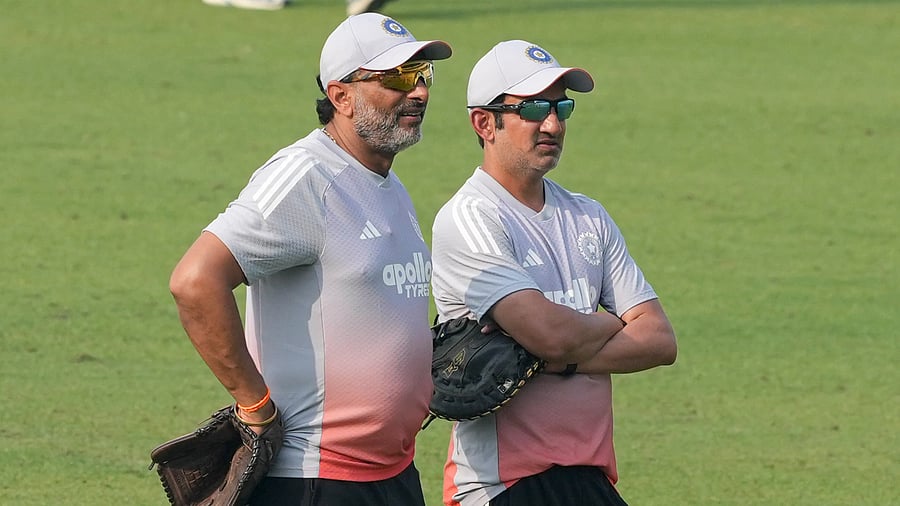
The India team's performances in Test cricket under head coach Gautam Gambhir (right) continue to flounder with the defeat against South Africa in Kolkata on Sunday.
Credit: PTI Photo
Kolkata: Gautam Gambhir’s CV as India’s Head Coach looks formidable at first glance, yet it tells only part of the story. India have sparkled in white-ball cricket, but their Test performances have struggled to keep pace. Since taking over from Rahul Dravid, Gambhir has delivered multiple limited-overs series wins against England, South Africa, New Zealand and Australia, along with titles in the Champions Trophy (ODI) and the Asia Cup (T20).
The red-ball journey, however, has not followed the same script. Whether it is a question of skill, temperament or both, the Delhiite has not been able to inspire similar consistency in Tests. Apart from victories against lower-ranked Bangladesh and the West Indies, India have stumbled in one home series and one away series, losing to New Zealand by 3-0 and Australia by 3-1, and settling for a 2-2 draw in the five-Test contest against England.
The latest setback against South Africa in just eight sessions at the Eden Gardens on Saturday, pushed his tally to nine losses in 18 Tests.
Four of the seven wins under his tenure are against Bangladesh and the West Indies, and two other matches have ended in draws in Brisbane and Manchester. With the two-Test series against the Proteas already out of reach, India stand to have won only one of their last five Test series, a worrying statistic for a coach who almost never criticises team strategy or individual performances in public.
On Sunday, after his fourth loss in six home Tests, Gambhir faced the media. His answers created more puzzles than clarity. He wanted the batters to show greater application on turning tracks, yet he also suggested that the squad lacked experience in those conditions.
“It is not like there is a lot of experience in this dressing room, in the batting unit, if you see,” he began.
It is worth checking the numbers. Ravindra Jadeja entered the South Africa Test with 87 matches. KL Rahul has played 65, Rishabh Pant 47 and Yashasvi Jaiswal 26. Washington Sundar and Axar Patel, with 15 and 13 Tests respectively, may have fewer caps but can hardly be considered novices. And that is India’s core batting unit even before factoring in captain Shubman Gill.
So the inexperience angle does not quite add up.
Gambhir continued, “More than the skill, in Test cricket, mental toughness is more important. Regardless of how much turn there is, the first 10-15 minutes are important. Once you see that off, you get used to it. So it is the ability to absorb pressure.”
Admitting that he had requested the kind of surface India got, he had to defend the pitch and argued that it held no demons.
“You call it a turning track, (but) you see who took the wickets? Majority went to seamers,” he said. Fact check: Spinners took 22 and seamers 16.
“If on a so-called turning track, if you get out to seamers, I don’t consider it as a difficult wicket. It was a wicket where your technique would be challenged, mental toughness and more importantly the temperament to grind and bat long. If you attack, it is different. The ones who defended, whose defence was solid, made runs. We have played on such tracks before too.”
His contradictions surfaced again. While citing past examples to defend the pitch, he dismissed comparisons across eras.
“We can’t compare eras. That used to be the time when there was no DRS,” he replied when asked if today’s batters lack the skills to handle spin.
He continued to stand by the surface, arguing that it was far from unplayable. “We’ve always said that a turning wicket should be where the ball is turned very little on Day 1, so that the toss doesn’t become an important factor. We’ve never said that we want to play on a bad wicket or that we want to play on a rank turner. Ultimately, if we had won this Test match, you wouldn’t even be talking about such a pitch. So, my point is that we need to improve mentally and skill-wise. Rather than having a discussion about wickets because wickets are the same for both the teams.”
Gambhir closed the debate on conditions with a final assertion: "So, whatever we get in Guwahati, I think we’ve got the guys to deliver in any condition and on any surface as well."
And so the fundamental question remains unresolved. Is India struggling due to a shortage of skills, a shortage of temperament or simply because the pitches are too demanding?